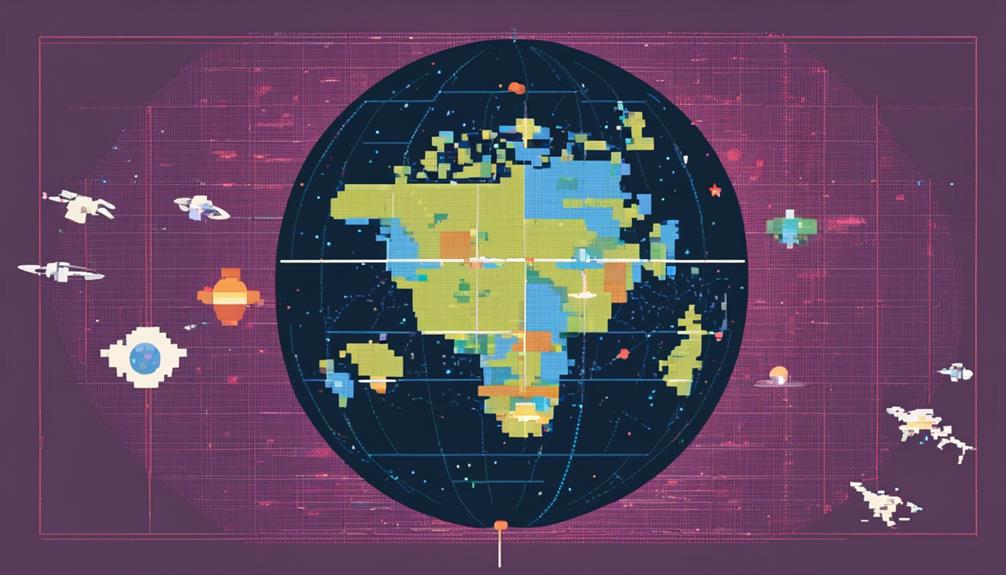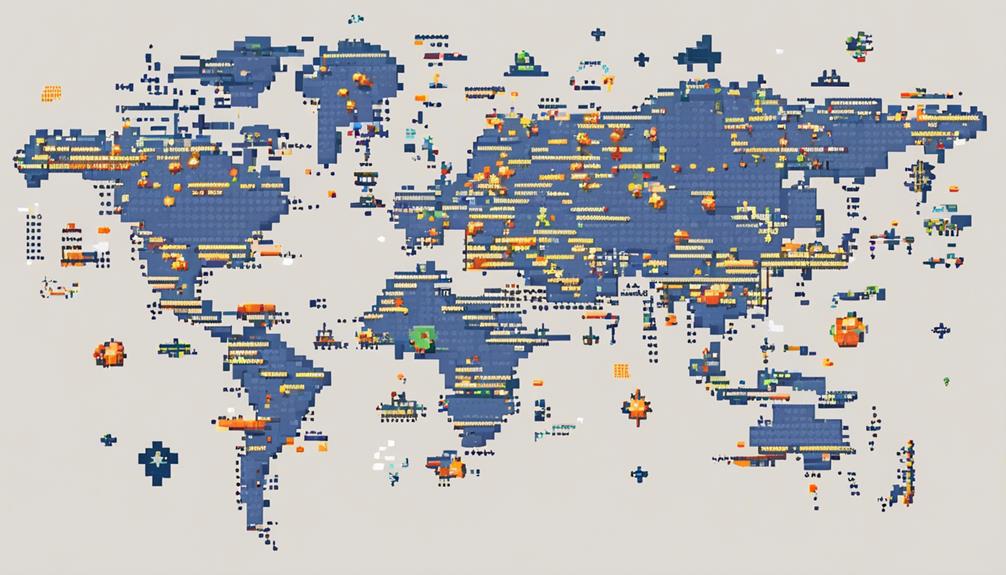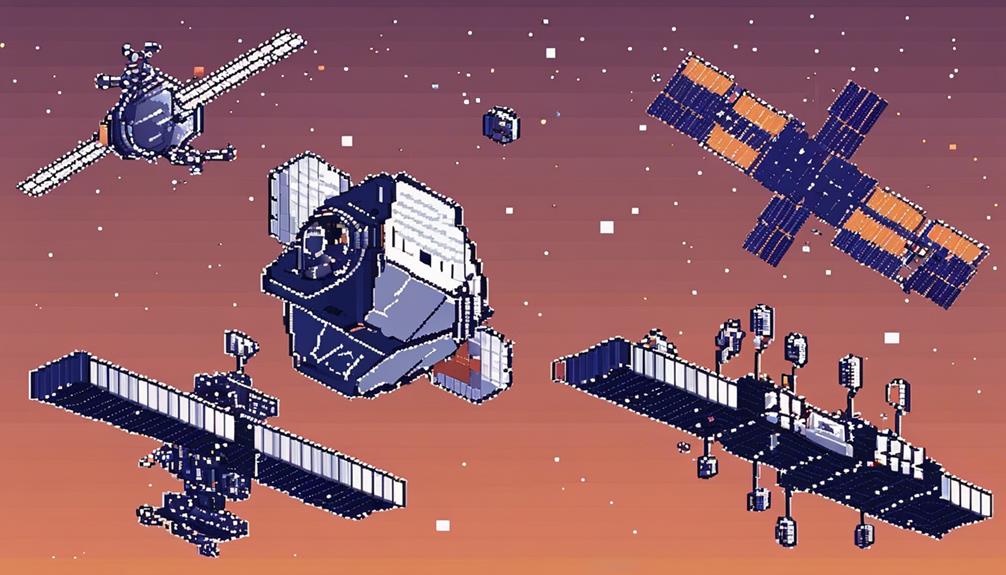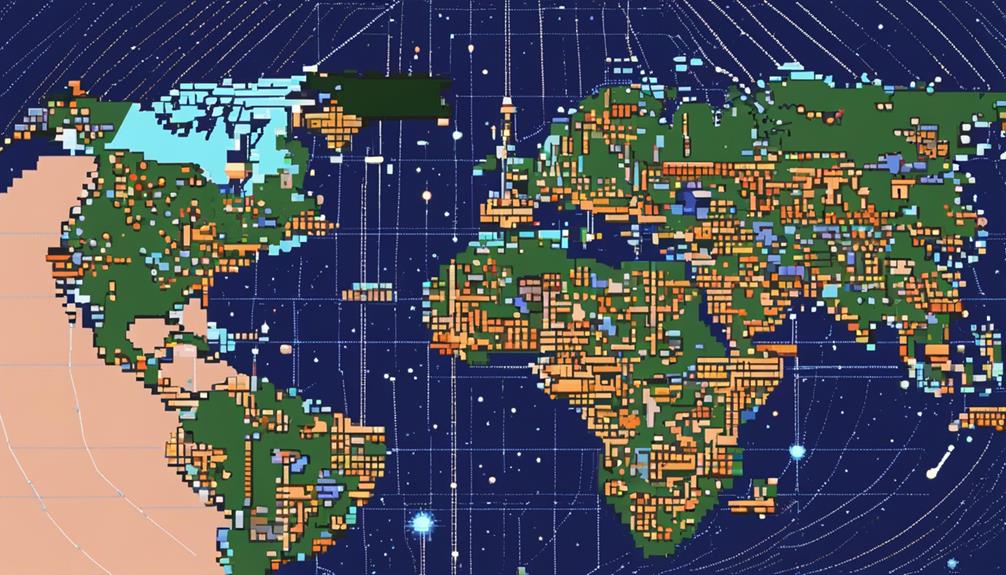The trajectory of satellite mega-constellations is a multifaceted domain encompassing intricate opportunities and challenges. The interplay of technological innovation and sustainability considerations within this sphere is poised to shape global communication networks in unprecedented ways. With the promise of enhanced connectivity and operational efficiency come intricate dilemmas such as orbital debris management and regulatory frameworks. Navigating this intricate web of advantages and complexities will be pivotal in unraveling the full potential of satellite mega-constellations in the foreseeable future.
Key Takeaways
- Mega-constellations enhance global connectivity with comprehensive coverage.
- Space debris management is critical for satellite safety and sustainability.
- Technological advancements drive efficient data transmission and network optimization.
- Regulatory frameworks must evolve to address challenges as satellite industry expands.
Global Connectivity Challenges and Opportunities

In the realm of satellite mega-constellations, the endeavor to achieve global connectivity presents a landscape rich with both challenges and opportunities. Low Earth Orbit (LEO) constellations like SpaceX's Starlink and OneWeb's project aim to revolutionize global communication through the deployment of thousands of satellites. However, this ambitious goal is not without its hurdles.
One of the primary challenges facing LEO mega-constellations is the issue of space debris. With an increasing number of satellites orbiting the Earth, the risk of collisions and the generation of debris that could threaten operational spacecraft is a significant concern. Proper debris mitigation strategies and responsible satellite disposal practices are essential to ensure the sustainability of space activities and to prevent the overcrowding of orbital pathways.
Moreover, the intense competition for orbital slots and radio frequencies among satellite operators poses a complex regulatory challenge. Effective governance mechanisms must be established to address issues such as spectrum allocation, orbital congestion, and potential interference with astronomical observations. Balancing the interests of commercial ventures with the need to preserve the space environment requires a coordinated international effort and robust regulatory frameworks.
In navigating these challenges, the opportunities presented by LEO mega-constellations for enhancing global connectivity and bridging the digital divide are substantial. By overcoming technical obstacles and implementing sustainable practices, the satellite industry can harness the full potential of space-based communication systems to benefit humanity.
Technological Advancements in Satellite Communication
Advancements in satellite communication technology have significantly enhanced the speed of data transmission and the reliability of signal delivery. High-speed inter-satellite links play a crucial role in facilitating efficient data transfer and minimizing signal interference, thereby improving global connectivity. These technological developments are vital in overcoming the challenges posed by the increasing complexity and demands of LEO mega constellations.
Speed of Data
Enhancing the speed of data transmission in satellite communication systems, particularly within Low Earth Orbit (LEO) networks, is crucial for achieving efficient and low-latency communication capabilities. Advancements in inter-satellite links within LEO networks play a significant role in enabling high-speed data transfer, ensuring seamless connectivity across the satellite constellation. Signal interference reduction in LEO networks is essential to maintain the clarity of communication channels, mitigating potential disruptions or data loss. Additionally, the efficient data exchange facilitated by high-speed connections within LEO networks enhances the overall performance and reliability of the communication system, benefiting a wide range of industries that rely on rapid and secure data transfer for their operations.
Signal Reliability
The quest for heightened signal reliability in satellite communication unfolds through cutting-edge technological innovations that underpin the seamless operation of mega-constellations like SpaceX's Starlink project. Starlink's over 1,500 LEO satellites employ laser communication technology, enabling fast and reliable data transmission essential for delivering high-speed internet globally. Autonomous systems within these mega-constellations optimize network coverage and connectivity, enhancing signal reliability. Advancements in data transfer capabilities within LEO networks further contribute to the improved reliability of global communication systems. Additionally, the integration of high-speed inter-satellite links ensures efficient data transmission, bolstering overall signal reliability.
| Technological Advancements | Description | Benefits |
|---|---|---|
| Laser Communication | Enables fast and reliable data transmission | High-speed internet delivery globally |
| Autonomous Systems | Optimizes network coverage and connectivity | Enhanced signal reliability |
| Data Transfer Capabilities | Improved data transmission within LEO networks | Better reliability for global communication |
| Inter-satellite Links | Efficient data transmission | Enhanced overall signal reliability |
Impact of Mega-Constellations on Global Connectivity

How do mega-constellations impact global connectivity in the realm of satellite technology and telecommunications? LEO mega constellations, such as SpaceX's Starlink and OneWeb's satellite network, have significant implications for global connectivity. Here are a few key points to consider:
- Enhanced Global Coverage: Mega-constellations like Starlink and OneWeb aim to provide global broadband coverage, especially in underserved or remote areas where traditional internet infrastructure is lacking. By deploying a large number of satellites in low Earth orbit (LEO), these constellations can offer more comprehensive and reliable connectivity to users worldwide.
- Increased Risk of Satellite Collisions: The growing number of satellites in LEO from mega-constellations raises concerns about the risk of satellite collisions. With thousands of satellites orbiting the Earth at high speeds, collision avoidance maneuvers and coordination between satellite operators become crucial to prevent disruptions to global connectivity services.
- Space Debris Management Challenges: The proliferation of LEO mega constellations contributes to space debris accumulation, posing risks to active satellites and spacecraft. Effective space debris management strategies, such as satellite deorbiting plans and collision avoidance measures, are essential to ensure the long-term sustainability of satellite networks and global connectivity.
Satellite Mega-Constellations and Space Debris Management
Amid the escalating proliferation of satellite mega-constellations, the management of space debris emerges as a critical challenge necessitating stringent mitigation measures. Mega-constellations like SpaceX's Starlink, with plans to deploy thousands of satellites, raise concerns about space debris management. The increased satellite population in Low Earth Orbit (LEO) intensifies the risk of collisions and debris generation, posing a significant threat to operational satellites and space activities. Effective space debris mitigation strategies are essential to safeguard satellite mega-constellations and prevent collisions, emphasizing the need for robust regulatory frameworks to address space debris concerns and ensure the sustainability and safety of these constellations.
| Aspect | Importance |
|---|---|
| Collision Risk | High risk due to increased satellite density in LEO |
| Debris Impact | Poses threats to operational satellites and future space missions |
| Mitigation Strategies | Essential for safeguarding satellite mega-constellations |
| Regulatory Frameworks | Crucial for ensuring sustainability and safety of constellations |
| Long-term Sustainability | Key focus to prevent space debris accumulation over time |
Effective management of space debris within the context of satellite mega-constellations necessitates proactive measures to mitigate collision risks, implement robust mitigation strategies, and establish comprehensive regulatory frameworks to uphold sustainability and safety standards in space operations.
Future Trends in Satellite Mega-Constellations

The future trends in satellite mega-constellations are marked by the emergence of advanced satellite technologies aimed at enhancing connectivity and communication on a global scale. With a focus on providing comprehensive internet coverage, satellite mega-constellations are poised to revolutionize the way we interact and access information. However, alongside these advancements, challenges in regulatory frameworks are anticipated as the satellite industry expands and evolves.
Emerging Satellite Technologies
Advancements in propulsion systems and integration of artificial intelligence are revolutionizing the efficiency and autonomy of satellite operations within mega-constellations. Emerging satellite technologies include:
- Utilization of laser communication systems for high-speed data transfer, reducing reliance on traditional radio frequency communication.
- Incorporation of robotics and 3D printing for in-orbit servicing and maintenance, enhancing satellite longevity.
- Use of advanced materials such as metamaterials and nanotechnology to improve performance, reduce weight, and increase durability in harsh space environments.
These technological innovations are reshaping the landscape of satellite mega-constellations, paving the way for more efficient and effective operations in the future.
Global Internet Coverage
With the increasing demand for global connectivity and broadband services, satellite mega-constellations like SpaceX's Starlink are poised to revolutionize internet coverage worldwide through their deployment of advanced satellite technology. SpaceX's Starlink project aims to provide global internet coverage by deploying thousands of Starlink satellites in low Earth orbit (LEO). Leveraging innovative technologies such as laser communication, these satellite mega-constellations can efficiently enhance connectivity on a global scale. By planning to launch 42,000 Starlink satellites, SpaceX is paving the way for high-speed internet access in underserved and remote areas, bridging the digital divide. With over 1,500 satellites already in orbit, the rapid progression of Starlink showcases the commitment towards achieving comprehensive global internet coverage.
Regulatory Challenges Ahead
Navigating the complexities of regulatory frameworks poses significant challenges for the future trajectory of satellite mega-constellations. Ensuring effective spectrum allocation is crucial to prevent communication interference among satellite mega-constellations. Licensing and registration processes for satellite operators play a vital role in monitoring the deployment of mega-constellations and maintaining regulatory compliance. International cooperation is paramount in establishing robust regulatory frameworks that can address the increasing challenges in space traffic management. Enforcing space debris mitigation strategies is essential to avoid collisions and sustain satellite operations effectively. Implementing monitoring mechanisms will be necessary to guarantee adherence to evolving regulatory requirements in the dynamic landscape of satellite mega-constellations.
Role of Small Satellites in Mega-Constellations

Harnessing the capabilities of small satellites within satellite mega-constellations is crucial for optimizing network coverage and operational efficiency in various space-based applications. Small satellites, weighing less than 500 kg, play a significant role in mega-constellations by offering cost-effective deployment options. These satellites are versatile, designed for tasks such as Earth observation, communication, and scientific research, making them valuable assets in the space industry.
One key advantage of small satellites is their ability to enable rapid deployment and replacement, enhancing operational flexibility within mega-constellations. Their compact size allows for multiple satellites to be launched simultaneously, increasing network coverage and ensuring a robust communication infrastructure in space. Furthermore, the rapid advancement of small satellite technology has paved the way for innovative applications in space exploration, pushing the boundaries of what is achievable in satellite operations.
Regulatory Framework for Mega-Constellations
Establishing a robust regulatory framework for mega-constellations necessitates a comprehensive understanding of licensing requirements and spectrum allocation guidelines. Licensing procedures are pivotal in ensuring that satellite operators adhere to international standards and obligations, while spectrum allocation plays a critical role in managing the increasingly crowded orbital environment. By defining clear guidelines for licensing and spectrum usage, regulatory bodies can effectively oversee the deployment and operation of satellite mega-constellations to promote sustainable space activities.
Licensing Requirements Overview
When considering the regulatory framework for satellite mega-constellations, the licensing requirements play a crucial role in ensuring compliance with international regulations and national laws for launching and operating extensive satellite networks.
- Satellite operators must obtain regulatory approval for launching and operating large networks of satellites.
- Compliance with spectrum allocation rules and space debris mitigation guidelines is essential for securing licenses for frequency spectrum usage.
- Licensing processes for mega-constellations typically involve coordination with national regulatory bodies and the International Telecommunication Union (ITU).
Spectrum Allocation Guidelines
The regulatory framework governing satellite mega-constellations places significant emphasis on Spectrum Allocation Guidelines to ensure equitable distribution of radio frequencies and prevent interference among extensive satellite networks. Spectrum allocation guidelines are crucial in defining frequency bands and coordination procedures to mitigate interference within and among mega-constellations. Regulatory frameworks, guided by international agreements such as the ITU Radio Regulations, establish rules for spectrum use by satellite operators to optimize bandwidth utilization and minimize signal disruptions in congested orbital regions. Spectrum management policies encompass frequency planning, interference mitigation strategies, and efficient spectrum sharing mechanisms tailored for the unique challenges posed by mega-constellations. Adherence to these guidelines is essential for the sustainable operation and success of satellite networks in an increasingly crowded orbital environment.
Satellite Mega-Constellations and Data Transfer Speed

Efficient data transfer speeds within satellite mega-constellations are crucial for ensuring seamless communication capabilities across global networks. LEO satellite networks, such as SpaceX's Starlink, play a pivotal role in enabling high-speed data transfer with low latency, revolutionizing space communication. Advancements in data transfer via LEO networks include the implementation of high-speed inter-satellite links, facilitating seamless data transmission between satellites in the constellation. These inter-satellite links enhance the overall performance of the network by reducing the reliance on ground stations and enabling faster and more reliable data exchange among satellites.
- LEO satellite networks leverage high-speed data transfer capabilities to minimize latency and enhance communication efficiency.
- Inter-satellite links within satellite mega-constellations improve data transmission speeds and overall network performance.
- Global coverage provided by LEO satellite constellations ensures connectivity even in remote regions, expanding communication possibilities and benefiting various industries.
Mega-Constellations and Global Internet Coverage
Revolutionizing global connectivity through the deployment of mega-constellations for global internet coverage is a strategic initiative undertaken by leading companies in the space industry. Starlink, SpaceX's ambitious project, plans to offer global internet coverage with a vast constellation of 42,000 satellites. These satellites operate in low Earth orbit (LEO), enabling them to provide low-latency, high-speed internet services worldwide. Similarly, OneWeb's LEO small-satellite communication constellation, comprising 684 satellites distributed across 18 orbital planes at an altitude of 1200 km, contributes to the goal of enhancing global connectivity.
The advent of LEO mega constellations, exemplified by initiatives like Starlink and OneWeb, holds the promise of revolutionizing internet accessibility and narrowing the digital divide. These constellations not only aim to deliver internet services to remote and underserved regions but also offer enhanced connectivity capabilities to urban areas. Companies such as SpaceX, OneWeb, and Amazon's Project Kuiper are spearheading the development of mega-constellations with the primary objective of achieving global coverage and transforming the way individuals and businesses access the internet on a global scale. As these projects continue to evolve, the potential for a more interconnected world through satellite technology becomes increasingly tangible.
Mega-Constellations and Environmental Impact

With the proliferation of mega-constellations in orbit, the environmental impact of these satellite networks is a topic of growing concern within the space industry. Mega-constellations have raised several environmental considerations that need to be addressed:
- Space Debris: The increasing number of satellites in mega-constellations raises the risk of collisions and contributes to the accumulation of space debris in Earth's orbit. This debris poses a threat to operational satellites and spacecraft, potentially leading to cascading collisions known as the Kessler syndrome.
- Light Pollution: Mega-constellations, such as SpaceX's Starlink, have been criticized for their contribution to light pollution, affecting astronomical observations and disrupting nocturnal wildlife. The excessive brightness of these satellites can interfere with the natural cycles of various species, impacting ecosystems.
- Sustainability: The cumulative impact of mega-constellations on Earth's orbital environment raises concerns about long-term sustainability. Balancing the benefits of global connectivity with environmental preservation is crucial to ensure the responsible deployment of satellite networks.
Addressing these environmental challenges requires a multifaceted approach that considers the mitigation of space debris, minimization of light pollution, promotion of sustainable practices in satellite deployment, and reduction of greenhouse gas emissions associated with satellite launches. Careful planning and international cooperation are essential to minimize the environmental footprint of mega-constellations while maximizing their benefits.
Satellite Mega-Constellations in Remote Areas
The expansion of satellite mega-constellations, exemplified by SpaceX's Starlink project, has significantly impacted connectivity in remote and underserved areas globally. These constellations, consisting of LEO satellites, play a crucial role in providing broadband connectivity to regions that lack traditional infrastructure. By offering global coverage, these satellite networks ensure that even the most remote areas can benefit from seamless connectivity, effectively bridging the digital divide.
LEO satellites in mega-constellations orbit closer to the Earth, enabling low latency communication services that are essential for real-time applications like video conferencing and remote sensing in remote areas. The deployment of these satellites enhances connectivity in underserved regions, empowering communities with access to a wide range of online services and information.
In remote areas where terrestrial networks are limited or non-existent, satellite mega-constellations are proving to be a game-changer, bringing high-speed internet connectivity to areas that were previously isolated. This advancement in technology not only improves quality of life for those living in remote regions but also fosters economic development by enabling businesses to participate in the digital economy on a global scale.
Collaborations in Satellite Mega-Constellations

Collaborations among key players in the satellite mega-constellation sector are pivotal to expanding and optimizing global communication networks. In the rapidly evolving space industry, strategic partnerships between companies like SpaceX, OneWeb, and Amazon's Project Kuiper play a crucial role in advancing satellite technology and enhancing global connectivity. These collaborations bring together expertise, resources, and technology to build robust satellite mega-constellations that offer improved coverage, reduced latency, and cost-effective communication solutions.
- Joint efforts in satellite mega-constellations focus on enhancing global coverage, ensuring that even remote and underserved areas have access to reliable communication services.
- Collaborative ventures aim to reduce latency in data transmission, enabling real-time communication and seamless connectivity for users around the world.
- International collaborations in mega-constellations facilitate the sharing of resources and expertise, driving innovation and sustainability in space-based communication systems.
Frequently Asked Questions
What Are the Benefits of Mega-Constellations?
Mega-constellations offer a myriad of benefits such as increased connectivity, faster internet speeds, global coverage, enhanced communication capabilities, and reduced latency. These constellations revolutionize data transfer and communication by ensuring seamless connectivity across vast regions, including remote and underserved areas. Through high-speed inter-satellite links, mega-constellations provide efficient and reliable communication services, unlocking new possibilities for various industries that rely on seamless and high-speed data transmission.
What Is the Future of Satellite Technology?
The future of satellite technology is poised for significant advancements in connectivity, innovation, and sustainability. With a focus on expansion, satellite companies are developing cutting-edge technologies to enhance global communication networks. These advancements include improved data transmission speeds, increased coverage areas, and enhanced satellite capabilities. The future landscape of satellite technology promises to revolutionize how we connect and communicate on a global scale, paving the way for a more interconnected world.
What Is the World's Largest Satellite Constellation?
The world's largest satellite constellation currently is SpaceX's Starlink, which plans to deploy 42,000 satellites for global communication. This expansive network aims to enhance global connectivity but raises concerns about space debris, regulatory challenges, environmental impact, and the need for effective space traffic management. As these mega-constellations grow, ensuring governance and mitigating interference with astronomical observations are critical for maintaining space environment stability.
What Is a Mega Satellite?
A mega satellite is a constellation of interconnected satellites deployed in low Earth orbit to provide global coverage for communication and internet access. These satellites offer advantages like enhanced coverage, reduced latency, and increased data transfer speeds. However, challenges such as space debris management, regulatory hurdles, and potential interference with ground-based astronomy must be addressed. The deployment of mega satellites has significant implications for improving global connectivity but requires careful consideration of these challenges.
